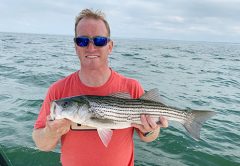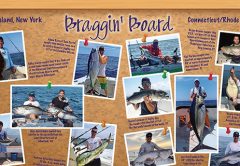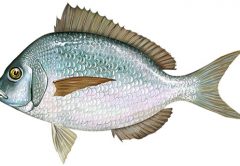M y boat is in the water, ready for the season and it should be time to catch some keeper Striped Bass. After a very cold April, I kept wondering where the Bunker schools and the Stripers that follow them were hiding. The only reports I heard were about all the seals at Nonations. Water temperatures were still in the mid 40’s and I read that this was the 2nd coldest recorded winter on Long Island; I believe it!
This season looks to be off to a slow start, but Mother Nature knows how to even things out quickly and you need to be ready. By opening day of the season, reports of keeper Stripers started to circulate around the docks. There will be fish here by the time you read this article. It will be more important than ever to take advantage of every opportunity you get. When you do get out make sure you get the freshest bait possible and find the warmest water you can to fish in. The back bay mud flats will be the places to be, as they will hold heat and warm the water.
By mid-May the fish should start to spread out into the Sound a bit and you should be able to find them on a lot of the reefs that are in our area. The best way to find these spots is to do some homework by looking at a map, they are all marked. The area off of Fort Totten is a favorite spot for many anglers in the Western Sound. If you don’t know this area well, don’t worry there will be a fleet of boats spread out and hard to miss. Be respectful of the boats already there, it won’t do anyone much good to crowd in to a spot; it’s a big area and you should be able to find some good bottom. Good Karma can’t hurt your fishing.
Remember to look for the Bunker Schools, they should have nice Bass around them, but don’t go running through the school because you will scatter the Bunker and spook the Stripers. I like to fish any structures I know of that might be near these Bunker schools also. Watch your sonar machine when driving around and you’ll be surprised how many little “pieces” you’ll find; they may not hold fish all the time, but it’s important to have options, especially if fishing is slow or someone is on your “favorite spot”. Most ‘favorite spots” are claimed by the multitudes as their spot, so don’t be surprised to find someone sitting there, don’t get upset (remember Karma) go to your next option. The Western Sound has been fished hard by many anglers for many years, but there are still things to learn every time you go out, a good fisherman will look and be open minded.
Bluefish, Fluke and Porgies should also start to appear in the Western Sound later this month. Last year the Fluke were more plentiful at this time of the year than in previous years and with the new regulations (5 Fluke at 18”) it should be a little easier to get some for the table. I like to “Bucktail’ for Fluke with light Spinning rods and reels filled with 20 pound braid tied to a swivel connected to 3’ of 30 pound Fluorocarbon tied to a 1 ounce white bucktail with a 4 inch curly tail either white or chartreuse tipped with local spearing. I also will use Gulp products and they seem to greatly improve the hookup ratio when things are tough. Drop your bucktail to the bottom and keep it bouncing so as to mimic a live bait fish. Fluke are very aggressive and want moving bait. You should drift ledges and drop-offs where Fluke will lie in ambush waiting for their meals. Once you hook the fish, keep you rod tip up and reel it in under steady pressure, pumping the rod will make it easier for the fish to shake the hook. If your fish is a keeper, keep its head in the water and use a net; once you lift the fish’s head out of the water they will get very excited and you can lose them very easily. If you can mark the spot on your GPS when you hook the fish, do it because there will be more than one Fluke there.
Porgy fishing will also get going soon; you need to chum heavily with frozen clam chum and have fresh clams and sand worms onboard because sometimes they can be picky. I’ll anchor up in 15ft of water in front of some structure, drop the chum to the bottom and start fishing. Light gear will let you enjoy the Porgy’s great fighting talents. Generally once they start biting, keep the chum going and they will cooperate; If not move around a little until you find them. Porgy fishing is a great way to introduce youngsters to fishing, they’re something the kids can handle and the action is consistent. Porgies are one of my favorite fish to eat, Long Island’s answer to Branzino. Although considered “bony”, they are easily filleted, if you don’t like them whole. As always make sure you ice your catch immediately as this will keep them prime for your dinner.









